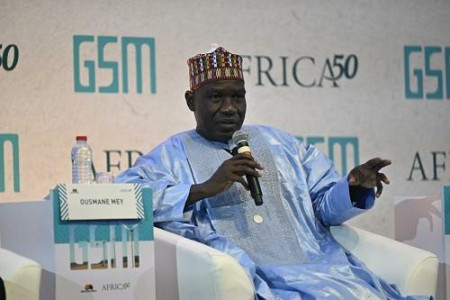Our Terms & Conditions | Our Privacy Policy
Cameroon Secures Africa50 Funding to Boost Infrastructure and Meet SND30 Goals
(Business in Cameroon) – In a recent interview with the public daily Cameroon Tribune, the Minister of Economy, Planning, and Regional Development, Alamine Ousmane Mey, shared positive news for Cameroon following the Africa50 annual shareholders’ meeting held on September 19, 2024, in Antananarivo, Madagascar. The country now manages assets exceeding $8 billion (about CFA4,692.5 billion) and has a portfolio of 25 projects, with expected dividends close to $200,000 (CFA117.31 million), according to the minister. He described this performance as “remarkable,” supported by an internal rate of return of 10.9%.
Mey emphasized the importance of Africa50 in helping Cameroon achieve the goals of its National Development Strategy 2030 (SND30). “After the impressive Nachtigal experience (420 MW), Cameroon is counting on Africa50 to assist in reaching the objectives of SND30. We plan to continue discussions with our partners to realize the Kikot Dam (500 MW) and Grand Eweng (1,000 MW), among other projects, to reach 5,000 MW by 2030,” he stated.
The Kikot-Mbébé hydroelectric plant, located on the Sanaga River, is expected to be one of the largest in the country, with an installed capacity of 500 MW. This project is managed by the Kikot-Mbébé Hydro Power Company (KHPC), a joint venture between the Cameroonian state and Électricité de France (EDF). The construction includes a dam nearly 1,200 meters long, a hydroelectric facility with six 83.3 MW Kaplan turbines, and plans for commissioning by 2030. With an estimated cost of over €1 billion (CFA650 billion), the project will receive funding from sources like the World Bank through the International Finance Corporation (IFC).
Regarding the Grand Eweng project led by the American company Hydromine, the plan is to build a dam on the Sanaga River, along with a power transmission line. In 2017, Hydromine projected a capacity of 1,800 MW for this dam, with an estimated cost of $3 billion. However, the Minister of Economy has recently revised this estimate to 1,000 MW. The company is currently facing challenges in finalizing the necessary funding, a process ongoing since 2019. These initiatives align with Cameroon’s ambition to reach 5,000 MW of installed power capacity by 2030, as outlined in the SND30.
“The ambition of Cameroon is to become an energy hub in Central Africa to support the region’s energy transition. Interconnection operations are currently underway. We will also explore asset recycling opportunities to create significant budget flexibility,” the minister highlighted. He expressed confidence in Africa50 as a key player in financing infrastructure in Africa, noting that support from international partners, particularly Africa50 members, is crucial to realizing this vision.
As a reminder, Africa50 is an investment platform founded by African governments and the African Development Bank (AfDB) to finance infrastructure through innovative funding mechanisms and strategic partnerships. Launched seven years ago, the Africa50 Fund currently manages 25 projects across 28 countries. Its main focus areas include infrastructure such as energy, transportation, information and communication technologies (ICT), and, more recently, health. This strategic approach addresses the growing investment needs on the African continent, where an estimated funding gap of $120 to $160 billion per year persists.
Images are for reference only.Images and contents gathered automatic from google or 3rd party sources.All rights on the images and contents are with their legal original owners.



Comments are closed.